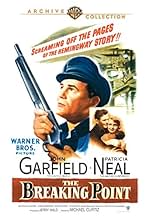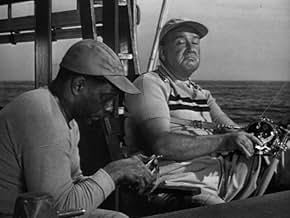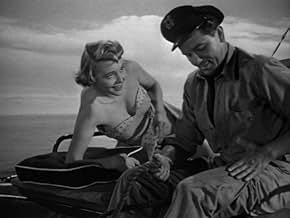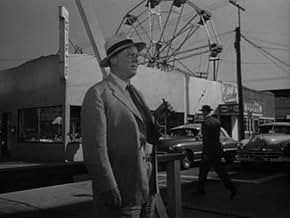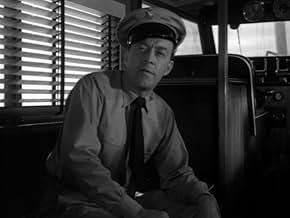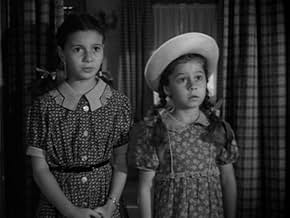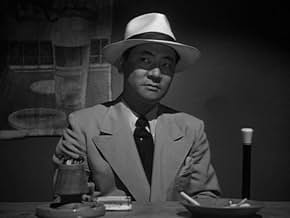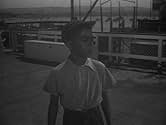IMDb RATING
7.5/10
4.9K
YOUR RATING
An otherwise moral captain of a charter boat becomes financially strapped and is drawn into illegal activities in order to keep up payments on his boat.An otherwise moral captain of a charter boat becomes financially strapped and is drawn into illegal activities in order to keep up payments on his boat.An otherwise moral captain of a charter boat becomes financially strapped and is drawn into illegal activities in order to keep up payments on his boat.
- Director
- Writers
- Stars
- Awards
- 4 wins total
John Alvin
- Reporter
- (uncredited)
Chet Brandenburg
- Taxi Driver
- (uncredited)
Peter Brocco
- Macho
- (uncredited)
Mary Carroll
- Girl at Bar
- (uncredited)
Spencer Chan
- 1st Chinese Immigrant
- (uncredited)
John Close
- Deputy
- (uncredited)
- Director
- Writers
- All cast & crew
- Production, box office & more at IMDbPro
Featured reviews
The Breaking Point cannot properly be called a remake of To Have And Have Not as that classic film was altered to make the story relevant for domestic consumption in wartime America. There was also added the legendary chemistry of Bogey and Bacall in their first film together. Ernest Hemingway did not write that for the movie-going public.
The Breaking Point is far more Hemingway and far more realistically done. John Garfield makes a perfect Hemingway hero and the locations along the California coast aren't glamorized in any way. This is a working class locale and the black and white cinematography and wind swept look given by same reflects Garfield and the area he is raising his family in.
Garfield plays a World War II veteran who wanted to earn a living on the sea and have Phyllis Thaxter raise their daughters in that coastal location. But business comes in cycles and a bad season finds Garfield owing everyone including the butcher, the baker and candlestick maker. Most of all he owes for fuel and that guy is ready to take the boat for payment.
When a charter client stiffs him on the bill, Garfield is forced to make some bad choices to pay his bills and support his family. Providing some of those bad choices is Wallace Ford playing a truly sleazebag shyster living on the Mexican side of the Pacific coast who ostensibly will get you a quickie Mexican divorce, but dabbles in all kinds of illegal fields. Actually I'm being unfair, shysters make bad lawyer jokes about Ford.
Providing a little temptation for Garfield is Patricia Neal who is trying very hard for the same Lauren Bacall effect. She's the girlfriend of the client who stiffed Garfield in the first place and she has most original and cynical point of view about life and men.
The Breaking Point provides John Garfield with one of his best performances in his next to last film. And he far more fits the Hemingway conception as does the overall film itself.
The Breaking Point is far more Hemingway and far more realistically done. John Garfield makes a perfect Hemingway hero and the locations along the California coast aren't glamorized in any way. This is a working class locale and the black and white cinematography and wind swept look given by same reflects Garfield and the area he is raising his family in.
Garfield plays a World War II veteran who wanted to earn a living on the sea and have Phyllis Thaxter raise their daughters in that coastal location. But business comes in cycles and a bad season finds Garfield owing everyone including the butcher, the baker and candlestick maker. Most of all he owes for fuel and that guy is ready to take the boat for payment.
When a charter client stiffs him on the bill, Garfield is forced to make some bad choices to pay his bills and support his family. Providing some of those bad choices is Wallace Ford playing a truly sleazebag shyster living on the Mexican side of the Pacific coast who ostensibly will get you a quickie Mexican divorce, but dabbles in all kinds of illegal fields. Actually I'm being unfair, shysters make bad lawyer jokes about Ford.
Providing a little temptation for Garfield is Patricia Neal who is trying very hard for the same Lauren Bacall effect. She's the girlfriend of the client who stiffed Garfield in the first place and she has most original and cynical point of view about life and men.
The Breaking Point provides John Garfield with one of his best performances in his next to last film. And he far more fits the Hemingway conception as does the overall film itself.
I just saw this movie in the last week at a recent Film Noir Festival here in San Francisco. Garfield owns this role as a down on his luck captain of his boat. He is willing to take shady deals to make money for him and keep his family (his two young daughters) with money. His wife played by Phyllis Thaxter gives a fine turn as a wife and mother. Patricia Neal is smooth and dangerous in her role as a two timing blonde broad. The daughters that played the kids were effective and smart like their ages were depicted. Garfield's mate Wesley Park was very good in his role of Garfiled's suffering partner. The reptilian role of the attorney was convincing and nasty. The final minutes of the movie had me choked up with the performances from Garfield and Thaxter. Another great movie by Michael Curtiz. Why isn't this movie on DVD?
The Breaking Point (1950)
Forget for a second that this is a Hemingway story, or that it was more famously and loosely made into a movie ("To Have and Have Not)" with Bogart and Bacall in 1944.
Here was have John Garfield playing with great realism a boating man, Morgan, who has hit hard times. So he is tempted by an illegal run for some big money. And it goes badly. Then, to get out of that jam, he is drawn into yet another one, which goes even worse.
So this is really a story of a man against the odds. He's basically a good person, which we see in how he treats his partner, his wife, his kids. But it's partly because of those others that he feels he has to come through and make some money. In a way, this is what Hemingway's novel is all about--how a man copes with crisis. (This is always what Hemingway is about, in a way.) It's great starting material.
The two women in the story, made to look slightly similar, are key in a Hemingway kind of way, too, because a Hemingway man is essentially torn by love all his life. Morgan's wife is terrific in a simple, unexciting way, and when Patricia Neal appears very sexually hungry, Morgan at first is not interested. Neal's character is not quite a noir femme fatale, since she really wants nothing for herself, but is a distraction and siren.
The two of them are terrific. Around them are a whole swarm of characters, some with important roles and excellent character actors, but we really get inside the head of Garfield and we really feel the weirdly brazen and carefree intensity of Neal.
So why is this a forgotten film? For one, Garfield is a low key leading man. He always is. His effect is subtle. And Neal isn't a steaming hottie or an outrageous caricature like some leading (blonde) women in these crime films. And then, frankly, they don't totally have chemistry on screen, which is neither one's fault alone, and which isn't so inaccurate to the story.
And about Hemingway? The book is great. You have to like his style and his manly view, but if you can adapt to that, read it. Easy reading, too. And he set the scene in the waters between Florida and Cuba, which is where he lived and fished. The Bogart version was set in the war, working for the French Resistance in Europe. The Garfield version was set (and shot) in California, with a trip to Mexico. A later version (1958) is set in Florida.
This is actually a first rate movie. Part of the success depends on the writing-both Hemingway and the sharp, noir-influenced screenplay by Ranald MacDougall. Note that the photography is by the great Ted McCord (Sound of Music, East of Eden, etc.).
The plot has some deeply personal aspects, both with Morgan's wife and kids as they barely scrape by and with the temptation of the sort of femme fatale played with a cool sharpness by Patricia Neal. And it has a serious crime plot with several angles that develop and disperse and develop further. It moves from dark night scenes to open water scenes to a faked fog ending (a flaw, visually, because you can tell it's just been processed for lower contrast even though the sun is out).
The movie also has some aspects that strike me as socially relevant, starting with the smuggling of a group of Chinese people out of Mexico at the start and ending with the tragic dilemma of a little African-American boy left literally alone on a big open dock at the final fade. This last aspect (which I can't get specific about without spoiling something) points to one of the really big interpersonal parts of the film that is key, and that I wish had been developed just a hair more because it's so key.
On my third viewing, I continue to like it a lot. See it.
Forget for a second that this is a Hemingway story, or that it was more famously and loosely made into a movie ("To Have and Have Not)" with Bogart and Bacall in 1944.
Here was have John Garfield playing with great realism a boating man, Morgan, who has hit hard times. So he is tempted by an illegal run for some big money. And it goes badly. Then, to get out of that jam, he is drawn into yet another one, which goes even worse.
So this is really a story of a man against the odds. He's basically a good person, which we see in how he treats his partner, his wife, his kids. But it's partly because of those others that he feels he has to come through and make some money. In a way, this is what Hemingway's novel is all about--how a man copes with crisis. (This is always what Hemingway is about, in a way.) It's great starting material.
The two women in the story, made to look slightly similar, are key in a Hemingway kind of way, too, because a Hemingway man is essentially torn by love all his life. Morgan's wife is terrific in a simple, unexciting way, and when Patricia Neal appears very sexually hungry, Morgan at first is not interested. Neal's character is not quite a noir femme fatale, since she really wants nothing for herself, but is a distraction and siren.
The two of them are terrific. Around them are a whole swarm of characters, some with important roles and excellent character actors, but we really get inside the head of Garfield and we really feel the weirdly brazen and carefree intensity of Neal.
So why is this a forgotten film? For one, Garfield is a low key leading man. He always is. His effect is subtle. And Neal isn't a steaming hottie or an outrageous caricature like some leading (blonde) women in these crime films. And then, frankly, they don't totally have chemistry on screen, which is neither one's fault alone, and which isn't so inaccurate to the story.
And about Hemingway? The book is great. You have to like his style and his manly view, but if you can adapt to that, read it. Easy reading, too. And he set the scene in the waters between Florida and Cuba, which is where he lived and fished. The Bogart version was set in the war, working for the French Resistance in Europe. The Garfield version was set (and shot) in California, with a trip to Mexico. A later version (1958) is set in Florida.
This is actually a first rate movie. Part of the success depends on the writing-both Hemingway and the sharp, noir-influenced screenplay by Ranald MacDougall. Note that the photography is by the great Ted McCord (Sound of Music, East of Eden, etc.).
The plot has some deeply personal aspects, both with Morgan's wife and kids as they barely scrape by and with the temptation of the sort of femme fatale played with a cool sharpness by Patricia Neal. And it has a serious crime plot with several angles that develop and disperse and develop further. It moves from dark night scenes to open water scenes to a faked fog ending (a flaw, visually, because you can tell it's just been processed for lower contrast even though the sun is out).
The movie also has some aspects that strike me as socially relevant, starting with the smuggling of a group of Chinese people out of Mexico at the start and ending with the tragic dilemma of a little African-American boy left literally alone on a big open dock at the final fade. This last aspect (which I can't get specific about without spoiling something) points to one of the really big interpersonal parts of the film that is key, and that I wish had been developed just a hair more because it's so key.
On my third viewing, I continue to like it a lot. See it.
... He is the same guy as always, struggling against odds, railing about making it, etc., but toned down a bit. He takes umbrage but there is a restraint that is not present in his earlier more angry-young-man roles. Maybe because he looks as little filled out and older and is a family man to boot. There is a relative maturity in the character that is appealing. Despite playing the proverbial "same role" as some actors are thought of as doing, there is no sense that he is phoning it in. And he holds up more effective than ever with the ultimate no-nonsense imperative of tough guys. Tough but regular too, I like the opening sally, i.e., to the effect that when out to sea a certain tranquillity can reign but back on land nothing but trouble. I like that, especially with the ultimate irony to come.
The domestic scenes are not Hemingway, but added for the movie. A wonderful decision. It rounds out Garfield's character giving him a softer side and allows for the domestic sweetness and wholesome prettiness of Phyllis Thaxter to be his wife. I like to feel that her all-to-obvious new hairdo was not lost on her husband and that it might have helped him decide on another matter regarding a certain lady.
Garfield's remark to his 10-year-old daughter about being "too old to run around (the house) like that" (i.e., in night clothes) was a surprising but effective slice-of-life detail that perhaps only in a small way ushers in the new 50s sensibility regarding such matters that will make films more frank and real with youth (teens) issues.
Patricia Neal is stunning as the would-be femme fatale, - would-be because she falls short of treachery. Her worldly manner and sophisticated beauty provides a stark contrast to Garfield's women in the story. She wants to seduce, and pending the outcome, have the goods on him for revenge. Is she too sympathetic for this? Up in the air,,pending definitions. Reliable veteran character actor Wallace Ford has a good gig as a low-level conduit to the underworld. He has good dialogue, pushy and sarcastic with his own clients but totally subservient when around the big boys. A happy addition to the story. The poor boy alone on the pier resonates and is discomforting.
The domestic scenes are not Hemingway, but added for the movie. A wonderful decision. It rounds out Garfield's character giving him a softer side and allows for the domestic sweetness and wholesome prettiness of Phyllis Thaxter to be his wife. I like to feel that her all-to-obvious new hairdo was not lost on her husband and that it might have helped him decide on another matter regarding a certain lady.
Garfield's remark to his 10-year-old daughter about being "too old to run around (the house) like that" (i.e., in night clothes) was a surprising but effective slice-of-life detail that perhaps only in a small way ushers in the new 50s sensibility regarding such matters that will make films more frank and real with youth (teens) issues.
Patricia Neal is stunning as the would-be femme fatale, - would-be because she falls short of treachery. Her worldly manner and sophisticated beauty provides a stark contrast to Garfield's women in the story. She wants to seduce, and pending the outcome, have the goods on him for revenge. Is she too sympathetic for this? Up in the air,,pending definitions. Reliable veteran character actor Wallace Ford has a good gig as a low-level conduit to the underworld. He has good dialogue, pushy and sarcastic with his own clients but totally subservient when around the big boys. A happy addition to the story. The poor boy alone on the pier resonates and is discomforting.
This is a remake of TO HAVE AND HAVE NOT that supposedly from what I've read sticks closer to the Hemingway story. Garfield could play the strong but tormented guy like nobody's business, here however we have most of the information needed in understanding just what's eating at this guy, wearing him down and making him afraid. "A man alone hasn't got a chance," he keeps repeating. But Harry isn't alone. He's got a family that loves him, a plain but good woman he adores, and who adores him. A best friend who is his shipping mate, yet he still can't shake the feeling that somehow the universe is against him, working overtime. He's like a man that needs some spiritual guidance. Something is missing. On first viewing this plays like a well done yarn. On subsequent viewings however, this film begins to haunt. The characters and scenes play on a deeper, more meaningful level. The domestic scenes, usually the throwaway, boring parts of a story like this, become the rock and Garfield and Phylis Thaxter emit genuine emotion and affection for one another that is unusually realistic. Patricia Neal is the temptress here, and in an unusual move, we're not supposed to fall in love with her or maybe even like her, which is evident in how she's physically presented. Her haircut is really bad and she's basically unflatteringly lit and photographed. She too looks realistic: like a once beautiful creature who's been around the block too many times and is starting to look all used up.
Juano Hernandez rounds out the main players as Garfield's friend and shipmate. It was Garfield who insisted the character be a black man and had the relationship between the two beefed up. According to Garfield's daughter, the studio didn't like the idea and tried to talk him out of it, eventually giving up. This casting led to someone (director Michael Curtiz?)coming up with that final shot in the film that hits like a sucker punch to the gut, unexpected and unforgettable.
Watch this one a second time and see if you agree.
Juano Hernandez rounds out the main players as Garfield's friend and shipmate. It was Garfield who insisted the character be a black man and had the relationship between the two beefed up. According to Garfield's daughter, the studio didn't like the idea and tried to talk him out of it, eventually giving up. This casting led to someone (director Michael Curtiz?)coming up with that final shot in the film that hits like a sucker punch to the gut, unexpected and unforgettable.
Watch this one a second time and see if you agree.
Did you know
- TriviaAccording to TCM's Eddie Muller, John Garfield thought this was his best performance and that it was the film of which he was most proud.
- GoofsWhen she first steps onto the boat, Patricia Neal's voice is heard saying "we're off to sunny Mexico," but her lips aren't moving.
- Quotes
Harry Morgan: You know, my wife dyed her hair.
Leona Charles: Coincidentally I've been thinking of letting mine grow out. Speaking of coincidences, I live in Number Seven. My friends just kick the door open.
- Crazy creditsTHE END close out. All lettering aligned and centered except for the line beneath Warner Bros. that begins PICTURES. It's left registered with whatever wording that followed it 'air brushed' over using the lower right drop shadow pattern leaving a Warner Bros. Pictures _?_?_?_?_ mystery.
- ConnectionsFeatured in The John Garfield Story (2003)
- SoundtracksPlease Don't Talk About Me When I'm Gone
(uncredited)
Music by Sam H. Stept
Lyrics by Sidney Clare
Sung by Patricia Neal in the bar
- How long is The Breaking Point?Powered by Alexa
Details
- Runtime1 hour 37 minutes
- Color
- Aspect ratio
- 1.33 : 1
Contribute to this page
Suggest an edit or add missing content




